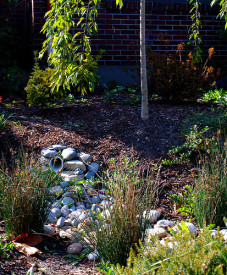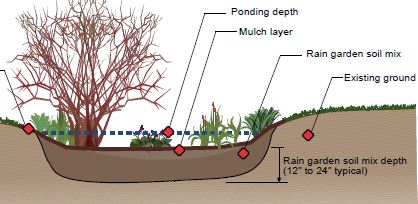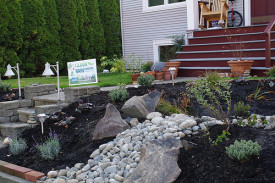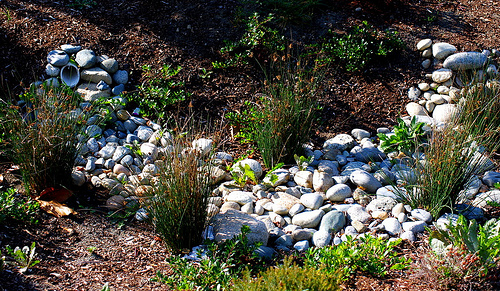
The recent dust up over troublesome amounts of pollutants leaching out of a Redmond rain garden got me thinking about soil. That’s because the soil in a rain garden has to meet a lot of needs, some of which are in conflict with each other. It needs to soak up potentially large volumes of stormwater quickly, filter and capture pollutants, keep plants alive through sodden winters as well as summer droughts, and avoid leaching nutrients. Plus, the ingredients for the soil need to be locally, readily, and affordably available.
We’re asking a lot of this dirt.
In Washington, the state’s official rain garden guide and its “2012 LID Technical Guidance Manual for Puget Sound” include specific recommendations for the “bioretention soil mix”—that’s the layer of soil that lines the rain garden. Washington calls for a mix that is 60 to 65 percent sand or soil excavated from the site, and 35 to 40 percent compost. The sand component helps with the drainage and filtering, while the compost provides nutrients needed by plants and trees and can help capture pollutants.
But the nutrients in the compost don’t always stay put, as Redmond and others have demonstrated. When these nutrients pollute rivers and lakes they stoke blooms of nasty algae that muck up the water, then die and suck oxygen out of the waterbodies as the tiny plants rot. If too much nitrate leaks from rain gardens into drinking water, the tainted water can cause “blue baby syndrome” in which infants are deprived of oxygen, turning their lips blue.
So I put the question: “Why so much compost in bioretention soil mixes?” to green stormwater engineers that included Curtis Hinman, the guy in charge of Washington State University’s Puyallup Green Stormwater Infrastructure Program.
Engineering vs. Nature
The stormwater experts reminded me that rain gardens need to support plant life—and that requires nutrients. Rain gardens aim to mimic nature by soaking stormwater into the ground so that it can replenish underground stores of water, preventing the rain from racing across paved and hardened surfaces, carrying tidal waves of polluted water into streams, lakes, and sea water. The plants help rain gardens absorb and treat the polluted runoff and they look a heck of a lot better than a bare, sandy ditch.

If you want to imitate nature, it helps to deconstruct it a bit. So researchers dug into native Northwest forest soils and found out that they’re 5 to 10 percent organic matter by weight, though usually closer to 5 percent, according to Hinman (see chapter 6 in this document for more detail).
By comparison, compost—like the stuff that’s made from residential yard waste and restaurant scraps—is 40 to 50 percent organic matter, and researchers use 40 percent as an average. But compost is much less dense than soil, so the amount of organic matter is significantly lower by weight.
After testing samples taken from actual bioretention soil mixes that were 60 percent sand/40 percent compost by volume, Hinman said that they found the mix contained approximately 5 to 8 percent organic matter by weight, with some samples measuring as low as 4 percent—right in the ballpark of Northwest forest soils.
Sampling of Soil Recipes

But rain gardens aren’t a local phenomenon, so how are they being built elsewhere? Native soil varies widely from Northwest rainforests to the deciduous woods of Delaware to Virginia’s Appalachian wilderness, and so do regional recommendations for rain garden soils.
Oregon, as one would expect, hews closely to Washington’s recipe for rain garden soils. Their bioretention soil mix or “3-way mix” calls for 60 percent sand and 40 percent compost.
When you head east, the advice changes somewhat.
Pennsylvania recommends that the planting soil used in rain gardens is:
- 20 to 30 percent compost
- 70 to 80 percent topsoil
Delaware and Virginia don’t specify how much compost is used, but rather give recommendations on the total amount of organic matter.
Delaware (see Standards & Specifications for Green Technology BMPs link):
- 1 to 4 percent organic matter
- 40 to 80 percent sand
- 20 to 40 percent silt
- 5 to 15 percent clay
- 3 to 5 percent organic matter
- 85 to 88 percent sand
- 8 to 12 percent soil fines

So even though rain gardens are essentially trying to do the same thing — control and treat runoff — the experts are coming up with a range of soil solutions.
The soil dilemma makes me think of “Cook’s Illustrated” — a publication that will test 40 recipes for chocolate chip cookies, tweaking ingredients and cooking techniques to create the perfect confection. Can there be a master recipe for rain garden soils — are there enough essential ingredients and construction approaches that span the nation?
Given the regional variability in soil, vegetation, and weather patterns, not to mention site-specific performance goals for different rain gardens, I’m betting we wind up with something more like locally-honed and beloved BBQ recipes in which each region has their own ratios of vinegar, tomato paste, and sugar. But different locations can certainly learn from the successes and mistakes experienced throughout the field, using that information to refine local soil mixes.
The challenge of finding universal soil truths becomes clear just by looking at organic matter alone. A soil recipe will call for x percent of organic matter or compost, but that ingredient can perform differently depending on its source. The phosphorus and nitrogen in freshly made compost, for example, isn’t the same as the nutrients in aged native soils.
Explains WSU’s Hinman in an email exchange:
A big issue here is that the compost OM (organic matter) is not the same as native soils OM and is more labile and susceptible to flushing/leaching than mature soil OM. That’s why we are looking into older compost and methods to change compost chemical properties.
Simpler Solution?
The complication and nuance required to build optimally-performing rain gardens sends me back to one of my favorite Puget Sound area stormwater gurus, Tom Holz, who has been a longtime advocate for smart environmental strategies.
He reminded me recently that while it’s well and good to treat stormwater runoff with rain gardens that attempt to replicate natural forests, if you really want to deal with polluted runoff, there’s a better solution: protect undeveloped land in the first place and avoid sprawling, high-impact development.
The problem is not with rain gardens. We are treating them as another
“end-of-pipe” nostrum to justify continuing high-impact development. That is the problem.
Of course when you’re in a heavily built environment, you’re dealing with a legacy of stormwater challenges that will benefit from green retrofits like rain gardens. But development continent-wide continues to creep and sprawl into green and wooded places, and those are the spots we should safeguard and allow nature do what it does best.

